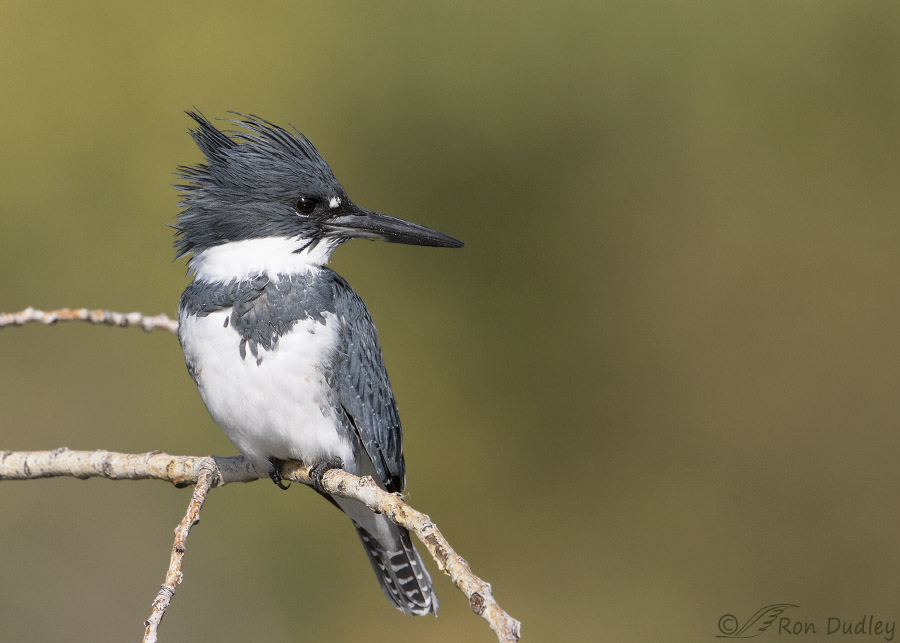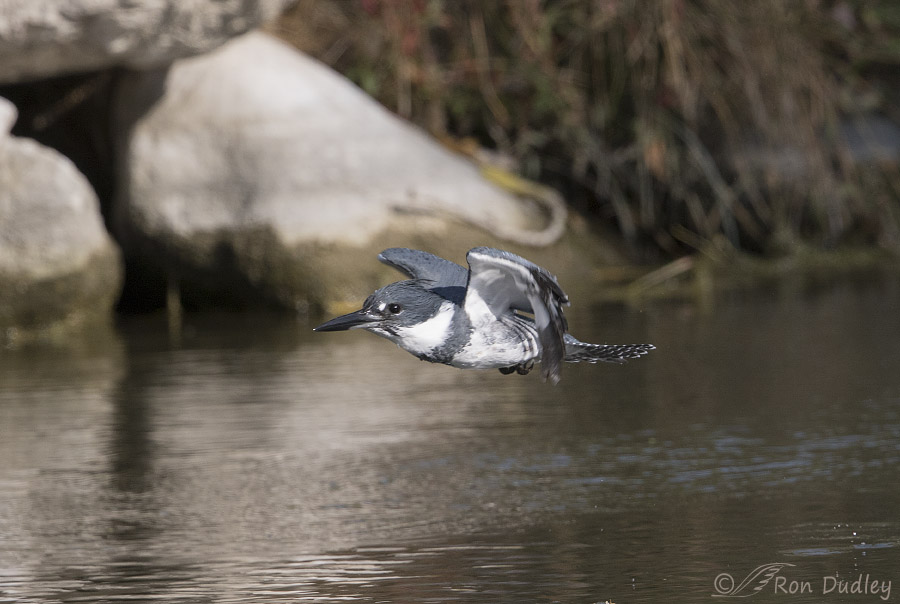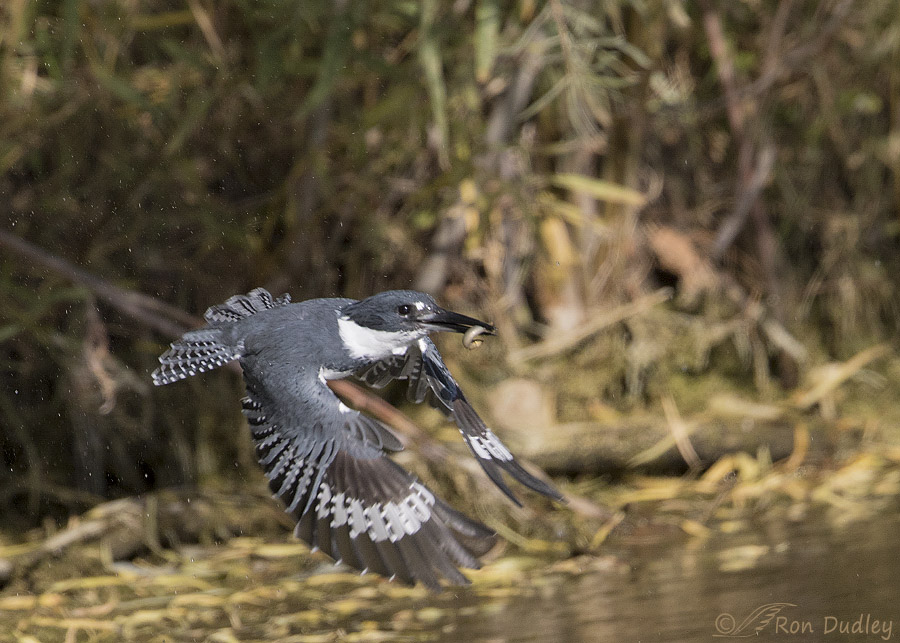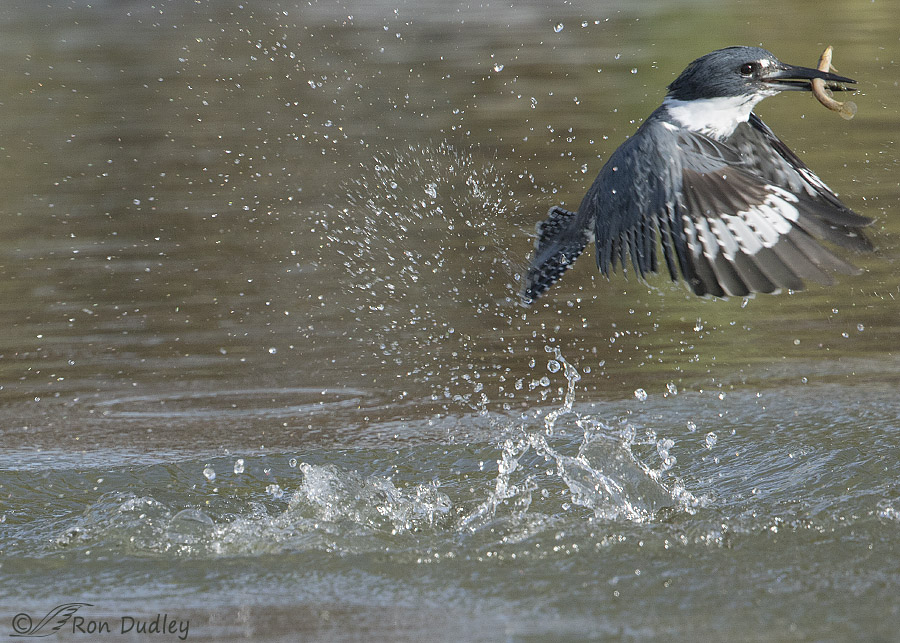I have certain lofty goals with Belted Kingfisher photos and I’m finally making some progress (but I’m certainly not there yet).
Yesterday morning I drove all the way to Bear River MBR and was essentially bird-skunked. That trip involved about three hours of driving to and from the refuge and several more hours of looking for birds so it was a frustrating morning to say the least. Lunch and a short nap after I returned home picked up my spirits and enthusiasm so I did a few chores and then tried to salvage the day in the late afternoon by looking for kingfishers closer to home. I’ve been trying for many weeks to find them and then get close (neither is easy) but they’ve always lived up to their elusive reputation.

1/5000, f/6.3, ISO 640, Canon 7D Mark II, Canon EF 500mm f/4L IS II USM + EF 1.4 III Extender, not baited, set up or called in
But this time I actually found a single occasionally cooperative male. After one of his fishing forays much further away he landed on this close perch at eye level to me and I got some shots of him that I quite like. It felt very good to finally have some kingfisher success again.
But there’s several types of kingfisher shots that I’ve lusted after for years and they’ve always eluded me. They include:
- kingfisher in full flight (not right after takeoff)
- kingfisher in flight with a fish in its bill
- kingfisher emerging from the water (including the dramatic water splash) with a fish it just captured
Any bird photographer who’s ever attempted these types of shots knows that they’re damn-near impossible to get with this species – the action is just too fast. Because it’s much easier many photographers get these types of photos using setups (placing fish in a plastic kiddie-pool, putting fish in a jar that floats near the surface etc. etc. – the list of slimy techniques is endless and they’re almost never disclosed) but I find those methods sleazy and dishonest for a nature photographer so I just keep trying. And failing.
I call the process of making the attempt “playing with kingfishers”.
But yesterday I came closer with all three categories of my “dream kingfisher shots” than I’ve ever come before and I include an example of each below. With any other species I’d have deleted all three of these images because of issues with composition and significant softness but for me these photos signify progress with my goals and I find that encouraging so I’m keeping them.
All three shots are of the same male as in my first image above.

1/2000, f/6.3, ISO 640, Canon 7D Mark II, Canon EF 500mm f/4L IS II USM + EF 1.4 III Extender, not baited, set up or called in
Here he had made an attempt at a fish, missed it, and then left the water to return to his perch. Long after he emerged from the water I almost acquired sharp focus on him. Maybe next time I’ll really lock on and get the bird tack sharp and larger in the frame (I really like the 3-dimensional qualities of this image).

1/1600, f/6.3, ISO 640, Canon 7D Mark II, Canon EF 500mm f/4L IS II USM + EF 1.4 III Extender, not baited, set up or called in
In this shot he actually has a fish soon after coming out of the water. I like the flight posture and the light but the bird is just too soft.

1/1250, f/6.3, ISO 640, Canon 7D Mark II, Canon EF 500mm f/4L IS II USM + EF 1.4 III Extender, not baited, set up or called in
And this could have been fairly close to my ultimate dream shot of a kingfisher. He has a fish and we see the dramatic splash from both his entrance into and exit from the water (they only stay in the water for about one second) but the kingfisher is much too soft and barely in frame.
I’m getting there but I still have some work to do. I’m convinced that the quest for the goal is almost as exciting and fulfilling as actual success as long as I’m making progress.
And besides, it’s evidence that this old fart bird photographer ain’t dead yet…
Ron
Note: I saw this male dive on a fish five times and he came up with a fish three (and possibly four) of those times. The fish was always an invasive weather loach.


This is a very handsome bird, and I like all the shots of him, despite what you say are flaws in the photos. I think it’s remarkable that you got all of them, and hopefully you’ll come up with even better ones soon.
Thank you, Susan.
Ron,
I am curious about your camera settings. The f-stop and ISO are always the same but the shutter speed varies with each shot. I am sure you would have preferred to have the shutter speeds reversed as it kept getting slower and slower in the series of images. I/5000 when the kingfisher is sitting still and 1/1250 when he is coming up out of the water. I am new at birds in flight so please help me understand. Thanks
John, I shoot in aperture priority so my shutter speed changes in varying light conditions. My SS dropped more than I hoped it would when I tried to get the bird coming out of the water and I didn’t have time to adjust my settings.
Ron,
So I assume the bird on the branch was in much brighter light than it was when it went fishing. Thanks
Late to the party once again, but any photo where I can glimpse those wonderful Kingfisher tail feathers is a winner in my book! Thanks again, Ron!
Nothing wrong with being late to the party, Diane. Some would say it’s fashionable! Thank you.
Love the pic of the Kingfisher coming out of the water.
Thanks, Jean.
Ron, I hope you don’t mind that I leave a message for Marina, please, never give up as there is always tomorrow. Be the best you can be, do the best you can do and that is okay.. Hugs! I made a mistake on the Blog from the man from Nelson, it is Exploring Kootenay Lakes >>>OOOps! Ron, there is not a dammed thing wrong with your Kingfisher photos, they are great and thank you!
I’m glad you like them as they are, Shirley. Thanks.
You certainly have been conquering your “nemeses” as of late! I hope these shots made up for your morning skunkdom yesterday. Wow! These are really special! Shot #3 seems to show details of every feather — it even looks like he may be missing a secondary from his left wing. I also love the splash patterns in the last shot. I know he’s closer to the right edge than you’d prefer, but for me the whole composition with all the splashes and the bird almost out of frame just enhances the excitement and sense of kinetic energy in the scene. That shot definitely tells the complete story of the action, which I feel would be diminished if the bird were more centered.
I hope these shots made up for your morning skunkdom yesterday. Wow! These are really special! Shot #3 seems to show details of every feather — it even looks like he may be missing a secondary from his left wing. I also love the splash patterns in the last shot. I know he’s closer to the right edge than you’d prefer, but for me the whole composition with all the splashes and the bird almost out of frame just enhances the excitement and sense of kinetic energy in the scene. That shot definitely tells the complete story of the action, which I feel would be diminished if the bird were more centered.
Marty, I agree that it’s nice to be able to see the entire splash but I’ll tell you the main reason why I don’t like that composition. The bird is just too close to the frame edge for me AND if I were to process that image as I should have it would be even closer because the image needs clockwise rotation (the water surface isn’t level). If I did rotate to level I’d lose even more room near the frame edge.
I agree with Marty 100%! Just sayin’!
OMG!!!!!!!!! Maybe just maybe someday????? But I am not doing good .. rather discouraged and haven’t been going out much .
Occasional discouragement comes with the territory, Marina. Hang in there!
Ron, I love those photos. The Belted Kingfisher is too fast for me so I manage to get them sitting, both male & female. They are so in reverse of most other species with the female being more colorful than the male. We have a local photographer here with a Blog, Explore Kootenay Lake that swears that the Belted Kingfisher is the hardest species to photograph so please pat yourself on the back for these amazing photos. My sister & I praise you for getting photos the proper way, with honesty. Thank you for being you!
Believe me, they’re too fast for me too, Shirley. But if I try often and hard enough everything may come together one day.
I appreciate your comment about the “proper and honest” way…
Love your persistence. And your (and our) rewards.
Love Patty’s comment that you are a dreamfisher. And Laura’s reminder that our species are dullards… On so many fronts.
Thank you, EC (wow, you’re up early!).
Insomnia and pain being put to use.
Very sorry to hear that, EC.
EC, makes you wonder how we’ve gotten this far, doesn’t it? I hate being a dullard, but there you have it.
I would rather not be a dullard too. But we emphatically are on so many levels. Superior species is empty bragging as far as I can see.
Want to mess with humans’ minds? Ask for the empirical evidence that humans are superior! And no, the Bible is NOT empirical evidence! Makes peoples’ heads spin–and that’s fun
And ain’t it annoying that our vision is so very slow. Overall, we’re dullards in the bird/critter world.
Yup.
Well, I think these shots are splendid–not perfect, but splendid anyway. But then, we know I’m easily amused, plus I GET the degree of difficulty involved.
Pursuing goals, trying and failing along the way, is such an important part of life. So many people think if they can’t reach expert status somewhere near immediately, they believe they can’t do that task and quit the trying and failing part–or more appropriately, the persistence part where you learn from your failures–often more from those. Obviously, there’s the element of common sense involved here. For example, no matter how hard we try, we cannot fly. Gravity requires that the dreaded SPLAT sound follows for those of us stuck to the ground without feathers and wings.
Native American artist, Buffy Sainte-Marie, believes that life should be about playing, that if we’re not playing in our life’s work, it becomes drudgery and we don’t do it well. But if it’s a joy to do what we’re doing, if you feel like you’re playing, the whole equation changes. When we’re doing what we are meant to do in this life, when we’re seeking and following our joy, that’s when we do good things. I agree with her. So you just keep on “Playing with Kingfishers” and it will all be worth the struggle in the end.
You wrote, “I’m convinced that the quest for the goal is almost as exciting and fulfilling as actual success as long as I’m making progress.” And that’s what the journey to perfection is all about. Then, you get it. And then, you gotta get it again. Life goes on.
I love mornings with Ron–I started this missive at 5:30 this morning, but then distractions happened and I did whatever it is I do to make whole paragraphs vanish, never to be seen/retrieved again. I hate it when I do that and wish I knew what THAT is. The rewriting is often a challenge, but life goes on. LOL!
Laura, I like Buffy’s philosophy. I’ve been very lucky in my life because I “played” while I was teaching and now that I’m retired I play at bird photography. Loving both activities allowed me to do that.
As I wrote that, I KNEW you’d made the decision to play in your life–that I was preaching to the choir. It took me a while to learn that lesson, but I finally got it and while I put in way more than the usual 40 hours a week, I wasn’t working at all. I was playing. I’ve made it a point to stick with that idea Life IS good!
Life IS good!
Great shots Ron, love em all! I agree with Alison, its the quest that keeps us going and sometimes just as exciting as the accomplishmentf!
Thank you, Dick.
Love this “slice of life” series in the day of a kingfisher. You have frozen activities that happen so fast with these jet powered birds you can barely see what’s happening. Wonderful!!! Guess your attempts at “perfection” re shots of these birds makes you a “dreamfisher”…they look great to me….any time I’ve seen them in the wild, they just look like a blue blur ro me…..
“any time I’ve seen them in the wild, they just look like a blue blur to me”
That’s one of the values of photos, Patty – to show us those behaviors that are just too fast for our eyes to really notice. Thank you.
Hi Ron, As a amateur bird photographer myself I know how hard it is to “play with Kingfishers”. With me is is almost a love hate relationship. Your
pictures are the kind I only dream of. Thanks for sharing.
Len
Yep, they’re tough subjects for any bird photographer, Len. Thank you.
These are great Ron! I especially like the one flying low along the water. I love the images where they have their wings low and forward so you can see there wing pattern. They are hard to photograph. One of my favorite memories is from last year getting bored with bears and choosing instead to spend two full days on an estuary watching kingfishers .
Ed, two full days with kingfishers is time well spent even without photographing them (though I’ll bet you did). Their entertaining antics and almost constant chattering would keep me fully entertained, even for that long.
GOOD JOB, Ron!:) It called “in my wildest dreams”………… Great to see one frozen in flight, and with a fish, and coming out of the water with a fish even if not perfect. Wonderful finish to a frustrating day. Our King Fishers are long gone now as are most birds. We did have a surprise visit from a small flock of Blue Jays in the past couple of days. Been many years since we’re out of their range – beautiful birds even if I know they can be a pain at times………
Our King Fishers are long gone now as are most birds. We did have a surprise visit from a small flock of Blue Jays in the past couple of days. Been many years since we’re out of their range – beautiful birds even if I know they can be a pain at times………
Judy, If our winter isn’t too cold and at least some of the flowing water stays open (not frozen) some of our kingfishers stay around all winter. However, they’re always few and far between that time of year.
Ron what might have been the shutter speed and ISO for the “horrible” kingfisher shots.
jake
I knew I should have included those image techs, Jake. Since they’re relatively poor shots I just got lazy…
I’ve added them now below those three images. More SS might have improved sharpness in several of them.
“I’m convinced that the quest for the goal is almost as exciting and fulfilling as actual success as long as I’m making progress.”
I really like this, Ron. That ‘process approach’ has clearly kept your engagement high while refining your goals. Here’s to a life of adventure and self-generated challenges!
Alison, I made that realization (that the quest is almost as fulfilling as actual success as long as I’m making progress) on the drive home from photographing the kingfisher. From looking at these images on my camera screen I knew they had issues but I was incredibly excited to have come as close as I did.
Absolutely sensational series Ron! CONGRATULATIONS
Charlotte
Thanks very much, Charlotte.
Lofty goals Ron and I truly hope you succeed. At this point in my Kingfisher career I would be happy with the perched bird. Kingfishers are primary example of a species that so far has never cooperated with me. Hopefully one may be in my future next summer in Montana.
Good luck, Frank. I know your frustrations. I tried for years before I got my first quality photos of a perched kingfisher.